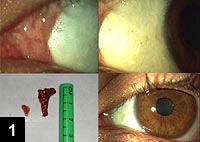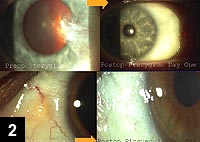Surgical method sets higher standard for managing pterygium
Day 1 postoperative cosmetic outcomes with glued amniotic grafts are raising patients’ expectations.
Click Here to Manage Email Alerts
Introduction

 Amar Agarwal |
Pterygium is one of the oldest pathologies known to ophthalmologists. Surgery for this condition can range from simple excision to techniques with exotic detail and meticulous maneuvers with task-specific instruments, beckoning an era of raised expectations and cosmetic outcomes in the field of ocular surface surgery itself. My special guest in this column is Arun C. Gulani, MD, who discusses the management of pterygium.
Amar Agarwal, MS, FRCS, FRCOphth
OSN Complications Consult Editor
The part of the pterygium that is visible is only the tip of the iceberg. By removing only this visible portion, the main pathology with its tentacles is not addressed and remains hidden under the conjunctiva. Pterygia can therefore have head/neck adhesion or peripheral/central adhesion. This can further be classified into diffuse and focal. In cases of peripheral adhesion, the pterygium easily peels off the cornea.
Draw test
When tugging on the cornea, some pterygia may be small in size but outright gritty and deep into the cornea, resulting in a thin cornea when removed. Preparation for this before surgery helps plan a smooth outcome (amniotic graft itself can be used as a lamellar fill). Also, removal of these pterygia is more difficult from the corneal surface.
Technique
The basis of my surgical steps (Figure 1) involves a lamellar approach along with atraumatic pterygium removal as a conjunctival scar with full dissection right up to the roots, including all arising heads, followed by contact subconjunctival mitomycin-C application, amniotic graft layering on the sclera with glue and reconstructing the fornix, if needed.
Topical anesthesia in the form of TetraVisc (tetracaine 0.5%, Cynacon/OcuSoft) is applied with preoperative topical Vigamox (moxifloxacin, Alcon). Intralesional anesthesia in the form of lidocaine with epinephrine is used 1 mL to 2 mL (this can also delineate the extent of the pterygium in obscure or recurrent cases). Depending on the appearance and draw test, I will decide to approach the pterygium at the contracted medial conjunctival fold and proceed medial to limbal or from the head toward the medial conjunctival fold.
 High magnification image of pterygium area at medial canthus (note cut end of remnant stump) postop (top left). High magnification image of pterygium area at limbus postop (top right). Iceberg concept: Small lesion is clinically visible pterygium. The lesion next to it is the actual size on removal (bottom left). The same patient, day 1 postop, with eye makeup (bottom right). |  Preop image of pterygium (top left). Day 1 postop image (top right). Preop image of pinguecula (bottom left). Day 1 postop (bottom right). Images: Gulani AC |
At the start of the procedure, the head of the pterygium is delineated from the cornea underneath. This can be done with a posterior-to- anterior sweep using the Gulani pterygium cross-action spreader. In cases of mild adhesions, the pterygium can be easily separated from the cornea (mostly peripheral pterygia) or effectively peeled in a single centrifugal movement.
After smoothing the cornea with a specially designed blunt blade, remnant tissue (especially in the gritty kind of pterygium) is meticulously removed with toothed forceps, medial to limbal directions always. The blade is used again to smooth the limbus. A Weck sponge soaked in 1:1000 epinephrine is used during this time, tucked away into the nasal crevice, where the cut pterygium is pressured into hemostasis. In this way, by the time this step is done, we approach a bloodless field for dissection. Also as an added benefit, we have created space for tucking the future amniotic graft.
The most important stage is dissecting the pterygium. The whole plane of the pterygium is delineated subconjunctivally as if separating a fan-shaped scar with tentacles into the fornices and medial angle. Keep the pull superior and vertical to avoid damage to the underlying medial rectus. In cases of recurrent pterygium, I habitually use a modified muscle hook — Gulani muscle manipulator — to ascertain the anatomy by hooking the medial rectus. When the pterygium mass is removed, it resembles a spreading mass of tentacles. It is important to remove the entire mass to avoid recurrence.
The pterygium is carefully dissected superiorly to avoid buttonholing the conjunctiva and invading the orbital septum, and inferiorly to avoid cutting the underlying muscles, which are re-checked after the pterygium is removed (Gulani-Tseng personal correspondence). There is none to very minimal bleeding during surgery. The cautery is to be used sparingly and then only for cosmetic reasons. Make it a point to patiently pick at the episcleral remnants to clear the underlying sclera in an attempt to remove all pterygium tissue from the area of impact.
Weck sponge pieces are soaked in mitomycin-C 0.04% and placed under the conjunctiva in the area of the dissection and left in place for 30 seconds. Avoid application to sclera. In fact, dry the sclera with a clean Weck sponge. After removing the sponges to a full count, the area is flushed with copious balanced salt solution.
I use the cornea as an illuminated receiving table to drape the amniotic membrane, which is then placed on the raw area and accepted with a tire-tool technique to avoid touching the membrane with any instrument, so it slips under the surrounding cut edge of the conjunctiva medially, superiorly and inferiorly. This is then milked to adhere to the globe contour using a specially designed forceps. Tisseel glue (fibrin sealant, Baxter AG) is now applied under the membrane and the membrane milked again in two quick sweeps to a pearly white and smooth appearance. Check the fornices for excessive glue, and clear with a forceps sweep. Too much glue may cause irritation and keratitis the next day if left behind.
In recurrent pterygia, the most important pearl I can offer is to dissect down until you reach the scleral bed — the previous ophthalmologist should have done a meticulous job of clearing the sclera. Now, dissect from behind forward, and the whole pterygium mass will lift up in a form I call the armor technique (very much like a thick plate of armor). The day 1 postop cosmesis and outcomes should be the same as a primary pterygium.
We are publishing from our series of 300 pterygium surgical cases using the above mentioned technique with no recurrence at 1 year follow-up and also extent of follow-up for cases up to 5 years postop. This is an ongoing study emphasizing day 1 postop outcomes.
Summary
Day 1 postoperative cosmetic outcomes with the no-stitch, no-patch and no-red approach, along with absence of visual deficit, are raising the bar in patients now seeking this approach for related ocular surface conditions such as pinguecula and conjunctivochalasis.
For more information:
- Amar Agarwal, MS, FRCS, FRCOphth is director of Dr. Agarwal’s Group of Eye Hospitals. Prof. Agarwal is the author of several books published by SLACK, Incorporated, publisher of Ocular Surgery News, including Phaco Nightmares: Conquering Cataract Catastrophes, Bimanual Phaco: Mastering the Phakonit/MICS Technique, Dry Eye: A Practical Guide to Ocular Surface Disorders and Stem Cell Surgery, and Presbyopia: A Surgical Textbook. He can be reached at 19 Cathedral Road, Chennai 600 086, India; fax: 91-44-28115871; e-mail: dragarwal@vsnl.com; Web site: www.dragarwal.com. Dr. Agarwal has no direct financial interest in the products discussed in this article, nor is he a paid consultant for any companies mentioned.
- Arun C. Gulani, MD, founding director of Gulani Vision Institute, can be reached at 8075 Gate Parkway West, Suite 102, Jacksonville, FL 32216; 904-296-7393; fax: 904-296-0393; e-mail: gulanivision@gulani.com; Web site: www.gulanivision.com. Dr. Gulani has no direct financial interest in the products discussed in this article, nor is he a paid consultant for any companies mentioned.
- Prachi Nandoskar, MD, a fellow in advanced LASIK and corneoplastique surgery at Gulani Vision Institute, assisted in data compilation for this article.
References:
- Gulani AC. Amniotic membrane lowers chance of pterygium recurrence. Ophthalmology Times. September 15, 2003.
- Gulani AC. Corneoplastique. Techniques in Ophthalmology. 2007;5:11-20.
- Gulani AC. Corneoplastique. Video Journal of Cataract and Refractive Surgery. 2006;Vol. 22:Issue 3.
- Gulani AC. Sutureless amniotic surgery for pterygium: Cosmetic outcomes for ocular surface surgery. Techniques in Ophthalmology. 2008;6:41-44.
- Gulani A, Dastur YK. Simultaneous pterygium and cataract surgery. J Postgrad Med. 1995;41:8-11.
